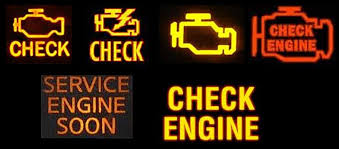CHECK ENGINE LIGHT
Let us check that light for you.

Check Engine Light?
We can help!
When your “CHECK ENGINE light comes on … DON’T IGNORE IT. Your vehicles system computer is telling you that something needs your attention soon!
A check engine light or malfunction indicator lamp (MIL), is a tell-tale that a computerized engine-management system uses to indicate a malfunction. Found on the instrument panel of most automobiles, it usually bears the legend engine, check engine, service engine soon, maintenance required, emmiss maint, or a pictogram of an engine—and when illuminated, it is typically an amber or red color.
The light generally has two stages: steady (indicating a minor fault) and flashing (indicating a severe fault). When the MIL is lit, the engine control unit stores a fault code related to the malfunction, which can be retrieved—although in many models this requires the use of a scan tool. This warning light can indicate almost anything from a loose gas cap to a serious knock in the engine.
On Board Diagnostic (OBD)
OBD stands for On-Board Diagnostics. It came about thanks to a mandate by the California Air Resources Board that required all cars from 1991 onward to be able to monitor emissions-related systems. The second generation (OBD-II) was implemented nationwide five years later and established a standard connector and communication protocol for all automakers. The port is always located in the driver’s side footwell, under the dash.
The fuel injection, ignition system and automatic transmission on most modern fuel-injected cars and trucks are run by one or more computers. These monitor sensors that collect data from the engine and other systems all over the car. The computers send commands to the fuel injectors and ignition coils to fire the cylinders. They use the data to fine-tune the combustion process with the correct amount of gasoline and the correct ignition timing to provide efficient, clean combustion for good power, economy and low pollution. There are dozens of sensors, measuring such things as throttle opening, engine rpm, air and coolant temperature, crankshaft and camshaft position, and road speed.
It’s a sophisticated, high-speed system with a lot of self-checks to keep your car running as intended for a long, long time. Tuneups are kind of outdated these days because this computer system self-corrects the fuel mixture and ignition at every crankshaft revolution. This is much better than it was decades ago, when you’d take the family bus down to the garage for that annual tuneup.
The standardization of this port means that any tool can be used to look at data from any car. Beyond the basic codes, some carmakers have manufacturer-specific data that offer even more information. And because the OBD-II can also report data such as vehicle speed, throttle position, and brake position, it’s handy for more than just troubleshooting. Insurance companies, fleet managers, and parents of teen drivers also use it to log data about driving habits.
Ronald Montonya from Edmunds wrote his thoughts on the check engine light. Automakers started standardizing their systems with 1996 model-year vehicles under a protocol called OBD-II, which instituted a list of diagnostic trouble codes and mandated that all cars provide a universal connector to access this information.
Check engine lights come in orange, yellow or amber, depending on the manufacturer. If the light begins flashing, however, it indicates a more serious problem, such as a misfire that can quickly overheat the catalytic converter. These emissions devices operate at high temperatures to cut emissions but can pose a fire hazard if faulty.
What Could Cause the Check Engine Light to Come On?
CarMD, an automotive telematics company, published a list of the 10 most common check engine codes in 2018.
1. Replace ignition coil(s) and spark plug(s)
1. Replace oxygen sensor(s)
3. Replace catalytic converter(s) with a new OEM catalytic converter(s)
4. Inspect for loose gas cap and tighten or replace as necessary
5. Replace ignition coil(s)
6. Replace evaporative emissions purge control valve
7. Replace mass airflow sensor)
8. Replace evaporative emissions purge solenoid
9. Replace fuel injector(s)
10. Replace thermostat

Occasionally, the check engine light comes on when nothing is wrong with the car, said Steve Mazor, chief automotive engineer for the Auto Club of Southern California. It could be a temporary problem caused by a change in humidity or other factors. In such cases, the light should go off by itself after a short time.
Don’t Ignore That Light
Mazor says that some people freak out when they see the check engine light. “They just put a piece of black tape over the dashboard light and keep driving,” he said. But Mazor adds it’s important to address problems indicated by the light promptly. Ignoring them could lead to larger, costlier problems later.
If the light comes on, Mazor suggests the driver should check the gas cap. A loose gas cap sends an error message to the car’s computer, reporting a leak in the vapor recovery system, which is one aspect of a car’s emissions system. If the fuel cap is loose, tighten it and continue driving. Even so, it will take some time for the light to go off, he says.
In addition to turning on the light—known as the International Check Engine Symbol—the computer stores a “trouble code” in its memory that identifies the source of the problem, such as a malfunctioning sensor or a misfiring engine. The code can be read with an electronic scan tool or a diagnostic computer—standard equipment in auto repair shops. There are also a number of relatively inexpensive code readers that are designed for do-it-yourselfers.
The code will typically just point you in the direction of the problem, and still requires an experienced professional to fully diagnose and repair the issue. Many car owners are turning to the internet to find the cause and remedy. This can work in some instances, but when in doubt, seek professional help.
